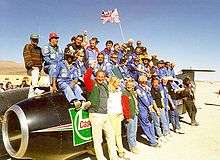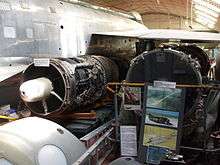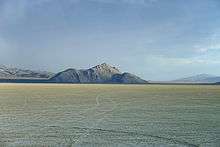ThrustSSC
| Thrust SSC | |
|---|---|
 | |
| Overview | |
| Manufacturer | SSC Programme Limited |
| Designer | Ron Ayers, Glynne Bowsher, Jeremy Bliss, Richard Noble |
| Body and chassis | |
| Class | Land Speed Record vehicle |
| Powertrain | |
| Engine |
two Rolls-Royce Spey turbofan:- initially: Rolls-Royce Spey 202 finally: Rolls-Royce Spey 205 |
| Dimensions | |
| Length | 16.5 m (54 ft) |
| Width | 3.7 m (12 ft) |
| Curb weight | 10.6 tonnes |
| Chronology | |
| Predecessor | Thrust2 |
| Successor | Bloodhound SSC |





ThrustSSC, Thrust SSC, or Thrust supersonic car, is a British jet-propelled car developed by Richard Noble, Glynne Bowsher, Ron Ayers and Jeremy Bliss.[1]
Thrust SSC holds the world land speed record, set on 15 October 1997, when it achieved a speed of 1,228 km/h (763 mph) and became the first vehicle to officially break the sound barrier.
Details
The car was driven by Royal Air Force fighter pilot Wing Commander Andy Green in the Black Rock Desert in the state of Nevada. It was powered by two afterburning Rolls-Royce Spey turbofan engines, as used in the British version of the F-4 Phantom II jet fighter. The car was 16.5 m (54 ft) long, 3.7 m (12 ft) wide and weighed 10.5 tons (10.7 t), and the twin engines developed a net thrust of 223 kN (50,000 lbf), a power output of 110,000 bhp (82MW),[2] burning around 18 litres/second (4.0 Imperial gallons/s or 4.8 US gallons/s). Transformed into the usual terms for car mileages based on its maximum speed, the fuel consumption was about 5,500 l/100 km (0.05 mpg-imp; 0.04 mpg-US).
The record run in October 1997 was preceded by extensive test runs of the vehicle in autumn 1996 and spring 1997 in the Al-Jafr desert (located in Ma'an Governorate) in Jordan, a location unknown before for its capabilities as a test range for high speed land vehicles, with numerous advantages compared to the salt deserts of the Western United States.
After the record was set, the World Motor Sport Council released the following message:
- The World Motor Sport Council homologated the new world land speed records set by the team ThrustSSC of Richard Noble, driver Andy Green, on 15 October 1997 at Black Rock Desert, Nevada (USA). This is the first time in history that a land vehicle has exceeded the speed of sound. The new records are as follows:
- Flying mile 1227.985 km/h (763.035 mph)
- Flying kilometre 1223.657 km/h (760.343 mph)
- In setting the record, the sound barrier was broken in both the north and south runs.
- Paris, 11 November 1997.
The complete run history is available.[3]
Legacy
In 1983 Richard Noble had broken the world land speed record with his earlier car Thrust2, which reached a speed of 1,019 km/h (633 mph). The date of Andy Green's record came exactly a half century and one day after Chuck Yeager broke the sound barrier in Earth's atmosphere, with the Bell X-1 research rocket plane on 14 October 1947.
Both Thrust SSC and Thrust2 are displayed at the Coventry Transport Museum in Coventry, England. Thrust SSC is housed in a barrel-roofed hall. Visitors can board the pit trailer from which Thrust SSC runs were controlled, and can ride a motion simulator depicting a computer-generated animation of the record-breaking run from the perspective of Green.[4]
Several teams are competing to break the record, including Richard Noble's Bloodhound SSC project[5] and the North American Eagle project.[6]
Richard Noble–Orange-Intel dispute
In June 2012, a television advertisement for the Orange San Diego mobile phone, containing an Intel processor, was broadcast on British television and featured a fast car in computer generated imagery. Richard Noble claimed that the car was a representation of Thrust SSC and thus these companies had used his intellectual property without permission, putting the future of the Bloodhound SSC project in doubt. The Advertising Standards Authority rejected the Bloodhound team's complaint, claiming that intellectual property disputes were not in its remit. According to BBC News technology correspondent Rory Cellan-Jones, Intel and Orange responded that their production team had researched different styles of "superfast vehicles" and developed their own Orange-branded land speed car, and that the advertisement and phone were not connected to Noble or Bloodhound SSC.[7]
See also
- Air speed record
- The Blue Flame
- Budweiser Rocket
- Land speed record
- List of vehicle speed records
- RAF High Speed Flight
- Rocket car
Notes
- ↑ ThrustSSC team
- ↑ The ThrustSSC Story
- ↑ Thrust SSC Run database
- ↑ Coventry Transport Museum – Spirit of Speed Gallery
- ↑ Noble, Green and Team Target 1,000mph Record. Bloodhound Ssc (23 October 2008).
- ↑ Nash, Jim. "Rocket Man: Land-Speed Racer Pushes 1,000 MpH Barrier". Scientific American. Scientific American. Retrieved 9 March 2016.
- ↑ BBC News – Orange, Intel, and a fast car furore. BBC. (27 June 2012).
References
- Richard Noble: Thrust: The Remarkable Story of One Man's Quest for Speed, Hardcover: Partridge, 1998, ISBN 1-85225-268-5; Paperback: Bantam, 1999, ISBN 0-553-81208-4
External links
| Wikimedia Commons has media related to ThrustSSC. |
- Official Thrust SSC website (no longer being updated)
- Coventry Transport Museum where Thrust SSC is on display
- Photo-Diary by John Coppinger – including the aerial photo by Richard Meredith-Hardy showing the shock wave as Thrust SSC narrowly exceeds the speed of sound
- Thrust SSC the car and the run
- Thrust SSC Photos Pictures from Blackrock, Nevada – 15 October 1997
- Speed Record Club – The Speed Record Club seeks to promote an informed and educated enthusiast identity, reporting accurately and impartially to the best of its ability on record-breaking engineering, events, attempts and history.
| Achievements | ||
|---|---|---|
| Preceded by Thrust2 634.051 MPH, 1,020.406 Km/h set by Richard Noble, on 4 October 1983. |
FIA Outright World Land Speed Record holder (1 km) 713.990 MPH, 1,149.055 Km/h set by Andy Green, on 25 September 1997. |
Succeeded by ThrustSSC 760.343 MPH, 1,223.657 Km/h set by Andy Green, on 15 October 1997. |
| Preceded by Thrust2 633.47 MPH, 1,019.47 Km/h set by Richard Noble, on 4 October 1983. |
FIA Outright World Land Speed Record holder (1 mile) 714.144 MPH, 1,149.303 Km/h set by Andy Green, on 25 September 1997. |
Succeeded by ThrustSSC 763.035 MPH, 1,227.985 Km/h set by Andy Green, on 15 October 1997. |
| Preceded by ThrustSSC 713.990 MPH, 1,149.055 Km/h set by Andy Green, on 25 September 1997. |
FIA Outright World Land Speed Record holder (1 km) 760.343 MPH, 1,223.657 Km/h set by Andy Green, on 15 October 1997. |
Succeeded by Incumbent |
| Preceded by ThrustSSC 714.144 MPH, 1,149.303 Km/h set by Andy Green, on 25 September 1997. |
FIA Outright World Land Speed Record holder (1 mile) 763.035 MPH, 1,227.985 Km/h set by Andy Green, on 15 October 1997. |
Succeeded by Incumbent |
